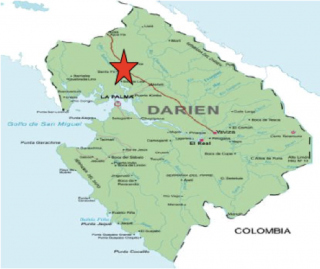Alto de Cristo, Panama
![]()
![]()
![]()
![]()
![]()
![]()
![]() Click on Programs to learn more about their work in this community
Click on Programs to learn more about their work in this community
General Information
| Population* | 220 |
| Number of homes | 61 |
| Avg # of people per home | 3.6 |
|
Number and % of children |
(0-5 yrs): 20 / 9.1% (0-12 yrs): 80 / 36.4% |
| Electricity | Yes |
| Corrigimiento | Santa Fé |
| District | Chepigana |
| Corresponding Health Center | Santa Fé |
| Distance from compounds | 15-20 minutes |
| Road conditions | Excellent |
* Population does not reflect how many patients will be seen on medical
brigades as many people from surrounding communities come seeking
Medical Brigades medical attention.
Top Needs Expressed
The top needs expressed by the community are water and health infrastructure, especially for their children's dental and overall health needs, as well as improvements to the school, and the construction of more latrines.
The community of Alto de Cristo has a primary school with a student population of 77 students. The school has 4 classrooms for grades 1-6, which means that classrooms have multiple grades within them. Without a secondary school in the community, students take a 10 minute bus ride to nearby Zapallal in order to continue their education.
Alto de Cristo has a water system, which is a gravity-based aqueduct system constructed in the 1990s. Water arrives on average in the community 5 days per week, and is chlorinated on a weekly basis. There is an established 7-member water committee, though they have not yet convened for a meeting. The tank that they have is known to have a leak, but water is still able to reach 95% of the houses with adequate pressure.
Alto de Cristo does not have a community health center, though there is a hospital accessible in Santa Fé 10 minutes away via bus. They do not have a basic sanitation committee, and the community complains of common ailments such as diarrhea, skin irritations, comiting, and headaches.
Approximately 95% of the community is estimated to have latrines, and 12 households have composting latrines. About 40% of homes are estimated to have cement floors.
The main source of income comes from agriculture, construction, cattle ranching, and general field labor. The main crops produced in the community are plantains, beans, corn, rice, and yucca. The community has a few small convenient stores, but in terms of access to credit and loans they have to go outside the community to larger banking institutions, which is often difficult and expensive.
In Alto de Cristo, the main method of waste-management is the burning and burying of their trash. A truck passes through the community to collect recycling every now and again, however no one in the community practices any recycling techniques. Furthermore, the community lacks an environmental committee.
Although there is no community lawyer or community members with any legal training, the majority of community members feel as though they would be able to access a lawyer if one was needed. 100% of families possess proper land titles, given to them through the government organization ANATI. Common legal conflicts that occur within the community are related to family issues.
None
Community members have expressed interest in building their relationship with Global Brigades; however, they mentioned that it is often difficult to motivate the community to work together, saying that there is an absence in leadership.
Source:
Interview conducted on-site August 11, 2012